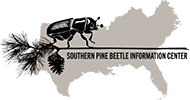Abstract
Since 1987, as many as 16 southeastern US states participate in a 4 wk. annual spring Dendroctonus frontalis (Zimmerman) (Coleoptera: Curculionidae) trapping survey. The purpose of the survey is to assess the current D. frontalis outbreak potential, and anticipate prevention and suppression needs for the coming yr. This prediction system relies on capturing the peak D. frontalis spring dispersal, thus timing of trap deployment is crucial. Forest managers traditionally attempt to deploy traps at the onset of flowering dogwood (Cornus florida L.; Cornaceae) bloom, which is commonly assumed to coincide with peak D. frontalis spring dispersal. The objective of this study is to examine the validity of dogwood bloom as an indicator of peak D. frontalis spring dispersal. Yr-round trapping data in 2014 and 2015 from Mississippi and Florida were used to identify peak D. frontalis and Thanasimus dubius (Fabricius) (Coleoptera: Cleridae) dispersal periods. Peak D. frontalis dispersal then was compared with dogwood blooming dates from the USA National Phenology Network and personal records. Then, both dogwood bloom dates and peak D. frontalis dispersal were compared with timing of actual historic state D. frontalis trapping efforts. We also compared peak D. frontalis dispersal with T. dubius peak dispersal, because T. dubius trap captures are used in the prediction model. Last, we examined the utility of extending the spring survey to 6 wk by comparing the 4 wk peak D. frontalis trap captures with a corresponding 6 wk peak. On average, mean onset of dogwood bloom occurred 3 wk after the peak 4 wk period of D. frontalis flight activity. The average T. dubius peak dispersal occurred 1.5 wk after peak D. frontalis dispersal. The 6 wk extension provided only a 12% overall average increase in D. frontalis trap captures. Eastern redbud (Cercis canadensis L.; Fabaceae) also had been suggested as a replacement trap deployment cue; therefore, eastern redbud and flowering dogwood blooming dates in 2019 were monitored on a Mississippi State University property in Oktibbeha County, Mississippi, USA. On this site eastern redbud trees bloomed on average 2.3 wk before the average bloom date of flowering dogwood trees.
Keywords
bloom; Cercis canadensis; Cornus florida; Dendroctonus frontalis; monitoring
To read the full article please visit the link below:
Thomason, John W., Stephen Clarke, and John J. Riggins. 2020. “Evaluation of Phenological Indicators for Optimizing Spring Southern Pine Beetle (Coleoptera: Curculionidae: Scolytinae) Trapping Surveys.” Florida Entomologist 103 (4): 444–51.
